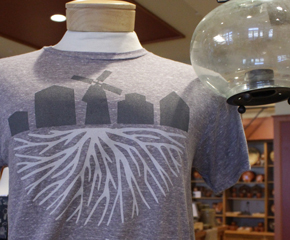
Henry Ford: Collector
Origins
Although Henry Ford became one of the world’s wealthiest and most powerful industrialists, he never forgot the values of the rural life he had left behind growing up on a farm. His interest in collecting began in 1914, as he searched for McGuffey Readers to verify a long-remembered verse from one of his old grade school recitations. Soon, the clocks and watches he had loved tinkering with and repairing since childhood grew into a collection of their own. Before long, he was accumulating the objects of ordinary people, items connected with his heroes and from his own past, and examples of industrial progress.

"History is More or Less Bunk"
In 1916, a series of articles in the Chicago Tribune attacked Henry Ford for his support of U.S. pacifism in World War I. In one article, Ford was quoted as saying, “History is more or less bunk.” Ford sued the Tribune for libel. At the trial that ensued, lawyers mercilessly examined Ford on a variety of schoolbook topics, especially history. As Ford answered question after question incorrectly, he replied in exasperation, “I did not say it was bunk. It was bunk to me…”
Henry Ford never really believed that history is bunk. What he believed was bunk was the kind of history taught in schools—that emphasized kings and generals and omitted the lives of ordinary folks. The trial inspired in Ford the idea of building a museum that would show people a kind of history that wasn’t bunk.
When I went to our American history books to learn how our forefathers harrowed the land, I discovered that the historians knew nothing about harrows. Yet our country has depended more on harrows than on guns or speeches. I thought that a history which excluded harrows and all the rest of daily life is bunk and I think so yet.
 Henry Ford
American Legion Magazine, October 1932
Henry Ford
American Legion Magazine, October 1932
Restorations
In 1919, Henry Ford learned that his birthplace was at risk because of a road improvement project. He took charge—moving the farmhouse and restoring it to the way he remembered it from the time of his mother’s death in 1876, when he was 13. He and his assistants combed the countryside for items that he remembered and insisted on tracking down.
He followed this up by restoring his old one-room school, Scotch Settlement School; the 1686 Wayside Inn in South Sudbury, Massachusetts (with a plan to develop a “working” colonial village); and the 1836 Botsford Inn in Farmington, Michigan, a stagecoach inn where he and his wife Clara had once attended old-fashioned dances. These restorations gave Ford many opportunities to add to his rapidly growing collections while honing his ideas for his own historic village.
Ford Home (Henry Ford's Birthplace) at Its Original Site, Dearborn, Michigan, 1930
Artifact
Photographic print
Summary
Henry Ford began restoration of his Dearborn, Michigan, birthplace in 1919. He repaired or replaced the farm buildings and filled the small, white clapboard house with original or similar furnishings he remembered from his boyhood. He dedicated the restoration to the memory of his beloved mother, Mary Litogot Ford, who died in 1876. In 1944, the house and outbuildings were moved to Greenfield Village.
Keywords
Object ID
EI.1929.3155
Credit
From the Collections of The Henry Ford. Gift of Ford Motor Company.
Location
By Request in the Benson Ford Research Center
Related Objects
Get more details in Digital Collections at:
Ford Home (Henry Ford's Birthplace) at Its Original Site, Dearborn, Michigan, 1930
What is The Henry Ford?
The national attraction for discovering your ingenuity while exploring America’s spirit of innovation. There is always much to see and do at The Henry Ford.
Scotch Settlement School at Its Original Site in Dearborn Township, Michigan, circa 1926
Artifact
Photographic print
Summary
Henry Ford attended this one-room school from age seven to ten. In 1923, Henry Ford restored the school on its original site and operated an experimental preschool there--a precursor to the more extensive school system that Henry Ford started in Greenfield Village in 1929.
Creators
Object ID
EI.1929.P.O.6246
Credit
From the Collections of The Henry Ford.
Location
By Request in the Benson Ford Research Center
Related Objects
Get more details in Digital Collections at:
Scotch Settlement School at Its Original Site in Dearborn Township, Michigan, circa 1926
What is The Henry Ford?
The national attraction for discovering your ingenuity while exploring America’s spirit of innovation. There is always much to see and do at The Henry Ford.
Edisons, Fords and Firestones Visiting Wayside Inn, Sudbury, Massachusetts, circa 1924
Artifact
Photographic print
Creators
Keywords
United States, Massachusetts, Sudbury
Edison, Thomas A. (Thomas Alva), 1847-1931
Edison, Mina Miller, 1865-1947
Firestone, Harvey Samuel, 1868-1938
Object ID
P.188.5712
Credit
From the Collections of The Henry Ford. Gift of Ford Motor Company.
Location
By Request in the Benson Ford Research Center
Get more details in Digital Collections at:
Edisons, Fords and Firestones Visiting Wayside Inn, Sudbury, Massachusetts, circa 1924
What is The Henry Ford?
The national attraction for discovering your ingenuity while exploring America’s spirit of innovation. There is always much to see and do at The Henry Ford.
Sunday Parlor inside Ford Home (Henry Ford's Birthplace), 1923
Artifact
Photographic print
Summary
Henry Ford began restoration of his Dearborn, Michigan, birthplace in 1919. He repaired or replaced the farm buildings and filled the small, white clapboard house with original or similar furnishings he remembered from his boyhood. He dedicated the restoration to the memory of his beloved mother, Mary Litogot Ford, who died in 1876. In 1944, the house and outbuildings were moved to Greenfield Village.
Creators
Keywords
Object ID
EI.1929.3210
Credit
From the Collections of The Henry Ford.
Location
By Request in the Benson Ford Research Center
Related Objects
Get more details in Digital Collections at:
Sunday Parlor inside Ford Home (Henry Ford's Birthplace), 1923
What is The Henry Ford?
The national attraction for discovering your ingenuity while exploring America’s spirit of innovation. There is always much to see and do at The Henry Ford.
The Botsford Inn, Farmington, Michigan, circa 1900
Artifact
Photographic print
Summary
In the 1800s, long-distance travelers often rode public coaches "in stages," jostling along rough country roads with mail, freight, and other passengers. Every few hours, the coach would stop to change horses. This tavern and meeting place on Michigan's Grand River plank road catered to coach traffic, serving as a stagecoach stop and providing meals and lodging to weary travelers.
Creators
Keywords
Object ID
84.1.1660.P.O.5584
Credit
From the Collections of The Henry Ford. Gift of Ford Motor Company.
Location
By Request in the Benson Ford Research Center
Get more details in Digital Collections at:
The Botsford Inn, Farmington, Michigan, circa 1900
What is The Henry Ford?
The national attraction for discovering your ingenuity while exploring America’s spirit of innovation. There is always much to see and do at The Henry Ford.
Something of Everything
In the early 1920s, Henry Ford moved his growing hoard of antiques into a vacated tractor assembly building. The objects fit every description. Large items hung from rafters; smaller ones sat on makeshift benches and racks. Watches and clocks hung along the wall. Henry and his wife Clara enjoyed sharing their relics with others. Once people learned Ford was collecting objects for a museum, they flooded his office with letters offering to give or sell him antiques.
Henry Ford, rightly or wrongly, never does things by halves, and in this instance he made a real job of it, and the result was one of the most amazing and complete collections of its kind.H.F. Morton Strange Commissions for Henry Ford, 1934
Ford also sent out assistants to help him find and acquire the kinds of objects he felt were important to preserve. Goods intended for the museum arrived in Dearborn almost daily—sometimes by the train-car full. By the late 1920s, Henry Ford had become the primary collector of Americana in the world.


















